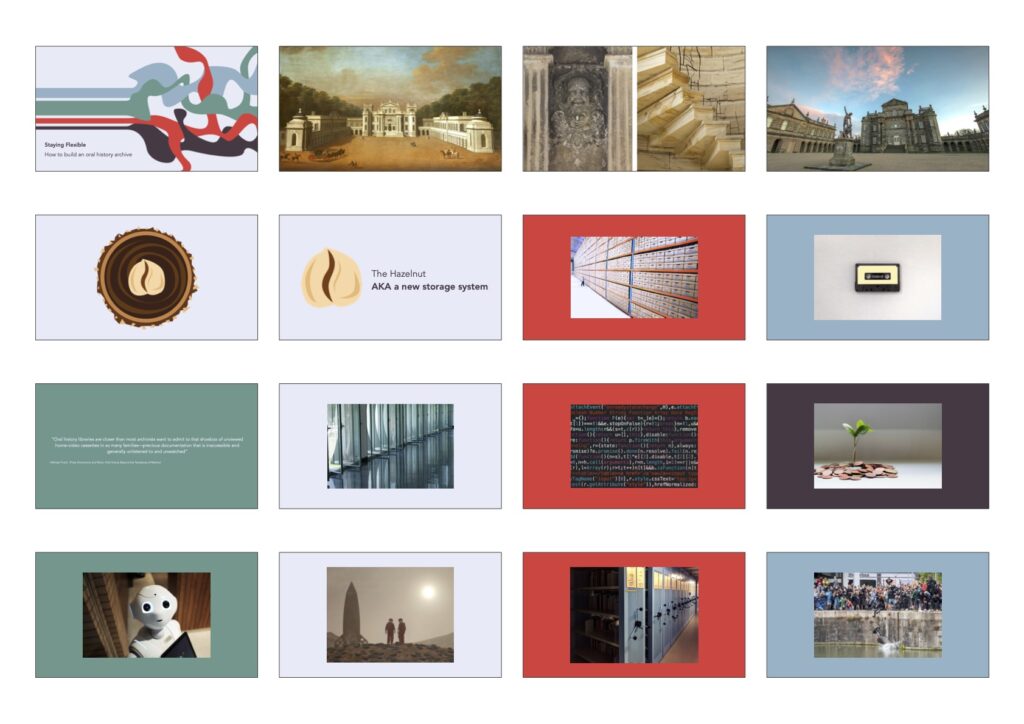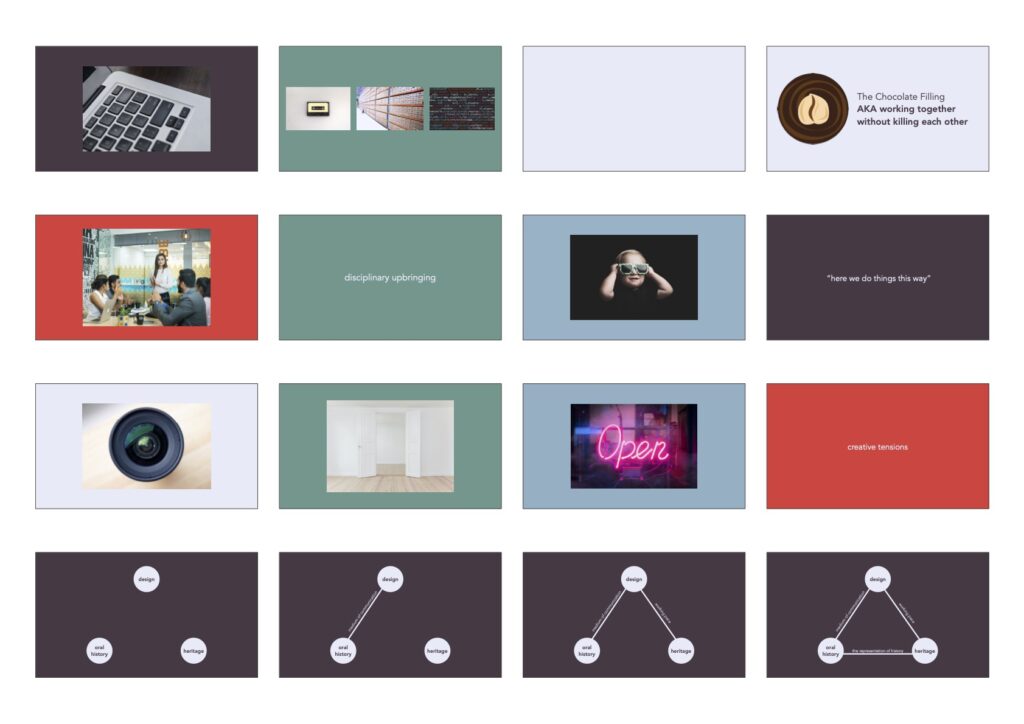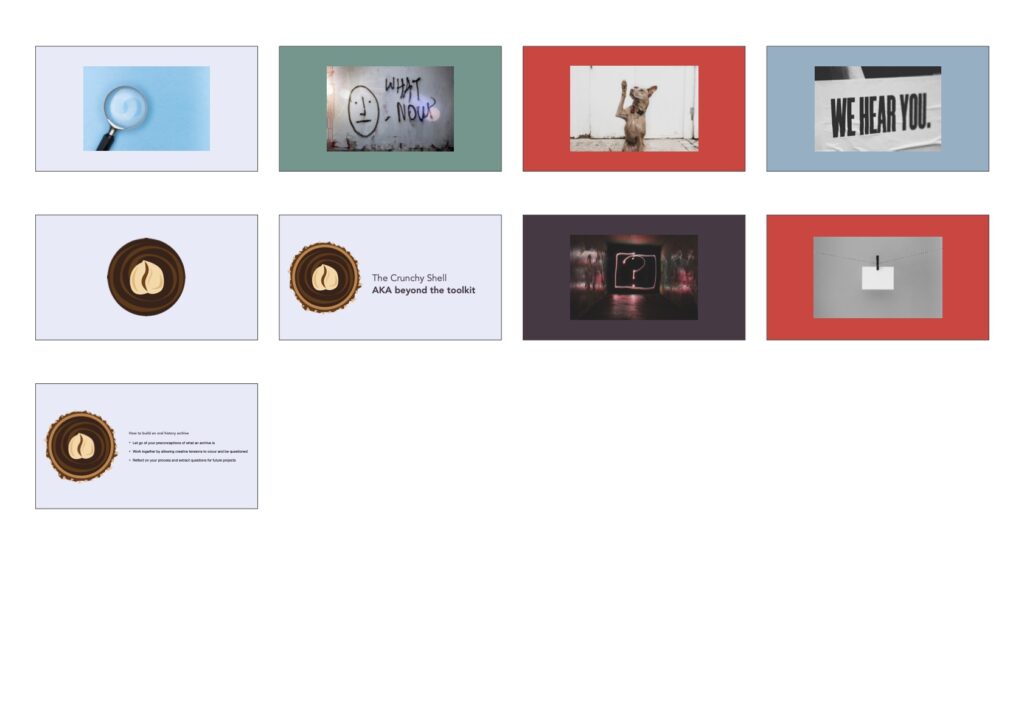The second conference paper I presented. This one went better than the first one so that is positive.
Slides



Script
[slide two]
This is Seaton Delaval Hall. This National Trust property can be found in Northumberland just up the coast from Newcastle. Built in the 1720s the hall and its residents, the ‘Gay Delavals’ became renowned for wild parties and other shenanigans.
[slide three]
In 1822 the hall went up in flames severely damaging the property. This history is well represented in the collection that is housed at the hall.
[slide four]
What is less represented, however, is the hall’s more recent history: the community that looked after the hall after it burnt it down, the prisoner of war camps, and the medieval themed parties that the late Lord Hastings threw after the hall’s restoration.
For my PhD I will attempt to solve this issue of missing history by building an oral history archive. Oral history is a tool that has been employed many times to help represent the underrepresented in history. The challenge however is to build an archive with these oral histories. To help me explain how I am approaching this challenge I will use a metaphor.
[slide five]
This is a Ferrero Rocher. Through this yummy treat I will attempt to explain my project and the various layers of the process that need to be considered and analysed in order to be able to build an affective oral history archive.
[slide six]
The Hazelnut AKA a new storage system
The metaphorical hazelnut and core of this project is this storage system that will hold the oral histories I record. Why do I call it a storage system and not archive? I say this for three reasons, firstly because archives and oral history recordings are not the best of friends.
[slide seven]
The original framework that we use to structure and build archives is, and has always been, based around archiving mostly written documents. Searching through this type of material is easy because their content is visually apparent. These days you can, if they have been digitise, word search the documents very easily.
[slide eight]
Oral histories recordings (not the transcripts) struggle to fit into this framework, because their content can only be accessed if you sit down and listen to them. Listening back to these recordings can take a lot of time and can be hindered by outdated technology. This mismatch between the material and the place where it is stored often discourages people to reuse oral histories.
[slide nine]
I think the oral historian Micheal Frisch puts it best when he called oral history archives “a shoebox of unwatched home videos.” The content is there but the viewing a specific moment is an arduous task. Mining the hall’s community for stories and throwing them into a shoebox is exactly what I want to avoid with this PhD.
[slide ten]
At Seaton Delaval Hall I want to create a storage system that broadens access to and actively encourages reuse of the oral histories, in order to support the community that has looked after the hall for so many years.
The second reason I say storage system instead of archive is ….
[slide eleven]
because currently archives are struggling with adapting to advancing technology. In recent years there has been a push to digitise archives with the COVID-19 pandemic giving this process an exceptional boost.
[slide twelve]
However, this digitisation requires a lot of resources like money, time and manpower that many archives, especially smaller ones, simply do not have.
[slide thirteen]
In addition, what this push to digitise does, which it does in many sectors, is attempt to replace a human with a robot, who in my opinion is simply not up to the task. Typing into a search bar is not the same as asking an archivist for help.
[slide fourteen]
While a search bar is a tool one uses when researching, the archivist becomes a fellow researcher, making room for far more flexible and creative exploration.
[slide fifteen]
Thirdly, archives are rather static in comparison to the world outside of their brick and mortar walls.
[slide sixteen]
Especially in the last year there has been increasing pressure to review how we present our history as a society. This dynamic debate is not reflected in the way we store our historical documents.
[slide seventeen]
This limited reviewing and updating of our archives actually makes it harder to do research. The most obvious instance being how certain keywords become outdated over time, which is something that is especially prominent in the archiving of minorities’s histories such as LGBTQA+ and Black history.
[slide eighteen]
The way we traditionally build an archive does not fit with contemporary society. Archives were initial set up to preserve one view of history in one type format. They did not leave room for new technologies and new points of view. Now, archives are attempting to change this by rather awkwardly moving into the digital space without truly questioning how these digital tools affect the archiving process and researching in archives.
In order to create a new storage system I wish to let go of these traditions, these symbols and languages that we use to navigate oral histories, archives and the digital.
[slide nineteen]
I want to start with a blank canvas and build a storage system that not only reflects the technology and views found in society but also makes room for any further developments in these areas. Now, the next question is: how we might go about building this new system?
[slide twenty]
The chocolate filling AKA working together without killing each other
[slide twenty-one]
AKA collaborating! A truly fabulous buzzword that works very well in funding applications but in reality is really difficult to do. Why? Well, every field of research has its own type of
[slide twenty-two]
‘disciplinary upbringing.’
[slide twenty-three]
When I say ‘disciplinary upbringing’ I am referring to the lens that each field views things like language and methods of work through. In other words the
[slide twenty-four]
‘here we do things this way’ attitude.
[slide twenty-five]
When people collaborate across disciplines they bring this lens, this disciplinary upbringing, with them so when the work starts everyone is viewing the challenge through separate and different lenses. This can lead to a lot clashes and plenty confusion.
So how do you solve this?
[slide twenty-six]
You could just say that people should leave their disciplinary upbringing at the door but that never works.
[slide twenty-seven]
Instead I intend on using these disciplinary upbringings to the advantage of the creative process by encouraging people to be open about them and in some cases even exaggerate them a bit. What this does is bring to light the various
[slide twenty-eight]
‘creative tensions’ that are present in the collaboration.
[slide twenty-nine]
For example in the context of this project where we have a collaboration between the fields of oral history, design and heritage you can find many creative tensions that are the consequence of differing disciplinary upbringings.
[slide thirty]
Between oral history and design there is the tension of the medium of communication; historians like writing and designers love a good visual.
[slide thirty-one]
I can tell you from experience that design and heritage work at dramatically different speeds. One of design’s key philosophies is “fail fast”, which is definitely not something would be mentioned in a National Trust meeting.
[slide thirty-two]
Finally, between oral history and heritage we find possibly the most challenging of creative tensions, which is differing opinions on the representation of history.
[slide thirty-three]
It is important to identify these creative tensions because they highlight issues that might have otherwise gone unseen if everyone had just been polite and kept their mouth shut.
[slide thirty-four]
Once they have been determined they function as a great source of information. This information needs to be drawn out through thorough questioning. It is essential to discover why the tension exists and how it might inform the creative process.
[slide thirty-five]
This does however mean that sometimes you might have to ask what seem like silly and obvious questions, because your disciplinary upbringing to begin with blocks you from fully understanding where other people are coming from. To complete the questioning to its fullest potential it is necessary to unpack any confusion no matter how small or trivial they might seem.
[slide thirty-six]
However the most fundamental thing within this chocolate filling of collaboration is — listening. One must always remember that you are not there to defend your disciplinary upbringing, you are there to solve a collective problem. When identifying and questioning creative tensions everyone must listen to all of those collaborating.
[slide thirty-seven]
Overall the chocolate filling represents something that can be very difficult, but with open minds, questioning and listening can be exceptionally fruitful.
[slide thirty-eight]
The Crunchy shell aka beyond the toolkit
A Ferrero Rocher is not complete without its crunchy shell and neither would this project. The crunchy shell in this context represents the legacy of the project. It is important to me that the project and the storage system does not end with the completion of this PhD.
[slide thirty-nine]
In order to avoid this I and everyone involved in the project shall thoroughly question and analyse the process of building this storage system. We need to reflect on what worked and what didn’t work. This questioning needs to be beyond which workshop activity was fun and whether we had enough time.
[slide forty]
What we need to do is extract questions that will help someone else set up a similar project. So instead of creating a rigid set of instructions with painfully particular processes, we offer future oral history projects questions that they must ask themselves before, during, and after the project. This hopefully will allow them to adapt the process to their needs and encourages them to think more creatively.
[slide thirty-nine]
Conclusion
Now I completely recognise the irony of me slamming the idea of a rigid sets of instructions and then ending on a how-to guide, but in my defence I had the title before I fully wrote the paper so please forgive me.
How to build an oral history archive
- Let go of your preconceptions of what an archive is (and also what the digital is)
- Work together by allowing creative tensions to occur and be questioned
- Reflect on your process and extract questions for future projects
The true aim of this how-to is to make sure that we do not end up in the same position we are now, where our archives no longer reflect society. The world is only going to get more complicated so if we do not leave room for questioning and change, archives are always going to be behind. This would be a disaster as archives on a macro scale are the keepers of our history and (in theory) hold the foundations of our collective identities as a people. On a more micro scale I have personally always found comfort in how archives keep documents that show everyday humanity, like a postcard to a fellow artist or a writer’s note to a partner.
So here is my how-to on making an oral history archive. Take it with you, try it out, tell me if it worked. I am going to do the same and probably change it many times in the next three years.